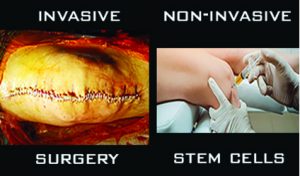By Dr. Ricardo Leano
 More than 1 million patients are having a knee or hip replacement every year in the US. Joint replacement consists of replacing a damaged joint with a new joint, usually made of a metal, plastic or ceramic, called prosthesis. Joint damage is caused by osteoarthritis, injuries and other diseases that cause joint wear. This surgery is usually considered after other treatments cannot improve symptoms. The rate of success is in the range of 90% and like any other surgery, it carries risks. Complications related to major joint replacement (hip or knee) are in the range of 4.5% in patients under age 65 and is more than double for older adults. Complications include:
More than 1 million patients are having a knee or hip replacement every year in the US. Joint replacement consists of replacing a damaged joint with a new joint, usually made of a metal, plastic or ceramic, called prosthesis. Joint damage is caused by osteoarthritis, injuries and other diseases that cause joint wear. This surgery is usually considered after other treatments cannot improve symptoms. The rate of success is in the range of 90% and like any other surgery, it carries risks. Complications related to major joint replacement (hip or knee) are in the range of 4.5% in patients under age 65 and is more than double for older adults. Complications include:
Blood clot in your legs (DVT) or lungs (PE) typically occurs within 2 weeks of surgery. This occur in less than 4% of cases but If the clot dislodges, it can be even fatal in rare cases.
Infection occurs in less than 2%. It may lead to many weeks in hospital, major disability in a few cases and more surgeries may be necessary
Complications from a transfusion. If blood is necessary during the surgery, all risks related to the transfusion are obviously transferred to you. This risk is low, but exists.
Allergy to components. Implants are typically made of cobalt-chromium alloy or titanium.
Anesthesia is generally safe, but can cause side effects (drowsiness, nausea/vomiting, sore throat) and adverse events (dental trauma, vocal cord injury, cardiac arrhythmias).
Nerve and vascular damage may happen.
Wound and bleeding complications. The wound may take longer to heal and may not even heal properly requiring skin graft. The cosmetic result is obvious even if skin heals well.
Joint stiffness is another complication due to scar tissue formation. Physical therapy (PT) helps to solve the problem, but another procedure or surgery may be required
Loss of function of the joint from inadequate PT or as a late sequela from infection or other complication will lead to disability
Implant failure and prosthesis problems may also happen. Lawsuits to manufacturing companies have been reported in billions of dollars.
Regenerative Medicine has the potential to fully heal damaged tissues and organs. There are few alternatives to help regenerate your damaged tissue. None of these alternatives are approved by the FDA, but some are more “accepted” than others. Those that involve manipulation of tissues or cells are considered experimental and are less accepted. The author, Dr. Leano, prefers the PRP (Platelet Rich Plasma), which is the most “accepted” on the eyes of the FDA. In some cases, especially in patients older than 70 years old, he combines PRP to other technique. All those available techniques are very well accepted and recommended by the scientific medical community. Not all the techniques have been widely adopted by all physicians, and Dr. Leano, at Palm Beach Pain LLC, uses only the most accepted and used techniques by the medical community. The procedure is extremely minimally invasive, and the risk of complications is minimal as well. The rate of success is in the range of 90 to 95% and the risk of infection is nil.
Total major joint replacement is a great procedure to recover the function of that joint damaged by osteoarthritis, trauma or other disease. But it carries complications and must be considered as the last resource of treatment. It is wise to try a Regenerative Medicine procedure before undergoing a major surgery. Please call (561) 248 1166 for an appointment to see if you are a candidate for Regenerative Medicine.
For any consultation, call
(561) 248 1166
for an appointment with
Dr. Ricardo Leano at
Palm Beach Pain, LLC
Check Also
The Latest Technology With Hearing Aids
Many modern electronic devices these days come equipped with Bluetooth technology. This feature lets you …
 South Florida Health and Wellness Magazine Health and Wellness Articles
South Florida Health and Wellness Magazine Health and Wellness Articles




